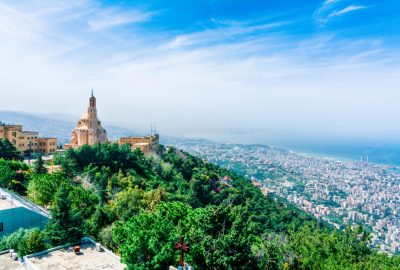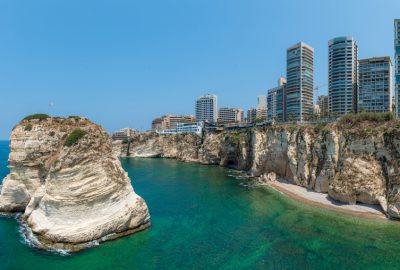Beirut is an oasis of peace in a country that knows only conflict. It’s a European city where European cities have no right to be. It doesn’t fit the mould; it’s out of place to the point that it’s bizarre. Beirut thrives, as it has thrived for millennia, despite all that violence. It’s been around for over 5000 years and went through a lot. They survived the Romans; and they came over the Ottoman rule, World Wars, Civil Wars, terrorism: you name it. After the Second World War, the Lebanese capital became a major tourist destination and financial hub. Beirut became a beacon of freedom, tolerance and modernization in a turbulent region, which always fell short of these things. Thanks to its French influences and rich cultural and intellectual life it was nicknamed Paris of the East. That all changed dramatically in 1975 when a disastrous civil war broke out. It was in the first place a clash between Muslim and Christian militias, but within these religion movements there were many conflicts between rival groups as well. And of course all was heavily influenced by the Palestinians-Israel conflict. It did not take long time before many countries in the region, especially the big neighbour Syria stacked in their noses. I remember that when I was very young Lebanon was a synonym for chaos. Those were the early eighties when the British synth-pop group Human League made a statement in its song “The Lebanon”. It was a true catastrophe indeed. Despite the involvement of the international community and all efforts of the international peacekeeping (UNIFIL) forces the city was completely ruined and the total death toll was estimated between 150,00 and 250,000 during those 15 years of civil war. The year 2020, which was already challenging because of Covid-19, turned out to be another catastrophic year for the Lebanese people. On 4 August 2020 a large amount of ammonium nitrate, which was stored for years at a warehouse in the city’s port exploded. Surveys showed it triggered shock waves which where the equivalent of a 3.3-4.5 magnitude earthquake. The blast was so immense that it could be felt in all neighbouring countries including Cyprus, which is almost 250 kilometres away. The disaster caused over 200 deaths and 7,500 injuries, and around 300,000 people became homeless.

More than twenty temples and monasteries are located on Mount Harissa near Beirut, one of the most beautiful and majestic is Basilica of Saint Paul
It is unbelievable: Beirut has been through so much and they’re still smiling. The Lebanese don’t dwell on the past, that’s for sure. Beit Beirut (https://www.beitbeirut.org/) stands as a monument to the times when the city was separated into Muslim and Christian halves, like Berlin. They adapted it and opened a museum and an urban centre inside. It’s a ruin littered with bullet holes. Gives you an idea of how Beirut looked like during all those years of struggle. It still is a struggle; favouritism and corruption are all over the place and authorities are detached from the people, which resulted in the 2016 garbage crisis. A landfill closed down and they didn’t have a backup plan, people swam in a river of garbage for weeks. It had a devastating effect on the trust of society in its rulers.
Tourists stay away from this region; governments advise against visiting Lebanon. No one plans their Beirut holidays; even mentioning the idea raises eyebrows. It’s 100km away from Damascus and the Syrian Civil War, yet you don’t feel the tension. Discovering Beirut is like finding a bar of gold in a dumpster fire. Sometimes you need to let go of your common sense and reach out into that flaming dumpster (please don’t do that, it’s a metaphor). It’s the people that make this city so special and pulled it back on its feet after so many misfortunes. The population of Beirut is a melting pot of generations of war refugees that were always welcome here. We Europeans like to complain about the migrant crisis, we don’t want those few hundred “aliens” in our cities. Lebanon took over two million in; they didn’t think twice. They understand there’s so much to gain if you open up to different cultures.
There is a lot to experience in Beirut; especially in the coastal area. People seem to forget that it’s a Mediterranean city. Villas of the rich and famous of the Middle East, politicians and important personas have lived a life of luxury here. But then things got hot and they all ran away, leaving their possessions behind. Parts of the coastline feel like a ghost town with abandoned resorts, mansions, aqua and Luna parks. A good spot for urban exploration like that is the area overlooking the famous Pigeon Rocks formation. Those rocks are the remains of the sea monster killed by Perseus, at least according to the legend. Walk a bit further north and you’ll find yourself at a seaside promenade. Enjoy the modern architecture, the luxurious shops, restaurants with delicious seafood and local specialties and a marina with state-of-the-art yachts. Feels like Cannes.

Raouche Rocks: one of the most popular and picturesque places in the city with many restaurants nearby, a landmark of Beirut
On top of it all: the city is blessed with a thriving club scene where the bold and the beautiful of the country like to show off their goodies. The older Beirut seems to be bothered by this modernization of their city. They think the younger generation escapes their past and throw themselves into consumerism instead of cultivating their heritage. Others combine both. Flea markets are a common way of connecting the past with the present and they’re everywhere. Pop-up stands and garages are filled with relics and antiques from the time of war. Most of it is probably looted from abandoned households but no one seems to mind. There are even more relics to discover. Recently discovered ruins of Roman Baths and the Forum of Berytus stand beside Beirut’s two most important religious buildings. St. George Maronite Cathedral and Mohammad Al-Amin Mosque are so close to each they look like one temple. I can’t imagine a better symbol of unity through diversity that is so clear in Beirut.
There is one, very surprising thing I came across in Beirut. You might think it’s a city of tents and camels but no. You can find camel-toes if you look hard enough but no camels on the streets. The funny thing is that the best ice cream in the world is actually served in a loud, a bit unbecoming hole in a wall. “Al Salam Ice-Cream” looks like a…veterinary clinic but the guy is something else. He can go on for hours how you can’t add any sugar to the cone so you can fully enjoy the taste of the treat. New York Times, Wall Street Journal, The Guardian, all praise this shop that has been running for generations, since before the civil war.



No one commented yet. Be the first.